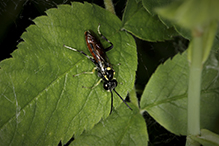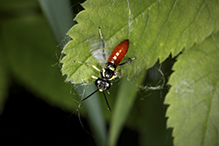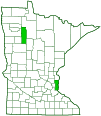common sawfly
(Macrophya pulchella)
Conservation • Description • Habitat • Ecology • Distribution • Taxonomy
|
|
||||||||||||||
Description |
Macrophya pulchella is a black, small to medium-sized, common sawfly. The female averages 5 ⁄16″ (7.5 mm) in length. The head is black. The mouth parts are white. The antennae have 9 segments. They are thread-like, cylindrical, and entirely black. The plate covering the thorax (pronotum) is black and with yellow markings. There is a yellow stripe wrapping around the forward (dorsal) edge of each side of the pronotum. The forward (anterior) portion of the stripe is narrow, the lateral portion is narrow to wide. The squarish plate at the base of each wing (tegula) is yellow. The triangular plate between the wing bases (scutellum) is yellow. The yellow spot on the scutellum is not divided or notched. The thorax and abdomen are broadly connected. The basal plate of the abdomen is always black. The first one or two abdominal segments are sometimes black. The sheaths on the ovipositor are partly or entirely black. The remainder of the abdomen is orangish-brown. The front and middle legs are mostly yellow to pale yellow. The tip of the fourth segment (tibia) is sometimes black. The last five segments (tarsi) together correspond to the foot of the insect. They are pale yellow with a narrow black tip. The hind leg is mostly yellow with black at the base, of the first segment, on the outer (apical) half to two-thirds of the third segment (femur), and the base and the tip of the tibia. The tarsi are pale yellow to almost white, with the base of the first segment and the upper surface of the last segment brown. The fourth segment (tibia) of the front leg has two spurs at the tip. The wings are clear and evenly tinged dark brown. The male is slightly smaller, averaging ¼″ (7 mm) in length. The antennae are slightly flattened. The scutellum is usually entirely black, sometimes partially black. The abdomen is entirely black. On the hind leg, the tibia is entirely black or it may have an indistinct pale yellow spot on the forward (ventral) edge, but never a yellow band around it. The male is otherwise similar to the female. |
Size |
Male: ¼″ (7 mm) Female: 5 ⁄16″ (7.5 mm) |
Similar Species |
Habitat |
|
Ecology |
Season |
|
Behavior |
|
Life Cycle |
|
Larva Food |
|
Adult Food |
|
Distribution |
||
|
Sources |
|
| 7/10/2025 | ||
Occurrence |
||
|
||
Taxonomy |
|
Order |
Hymenoptera (Ants, Bees, Wasps, and Sawflies) |
Suborder |
Symphyta (Sawflies, Horntails, and Wood Wasps) |
Superfamily |
Tenthredinoidea (Typical Sawflies) |
Family |
|
Subfamily |
Tenthredininae |
Tribe |
Macrophyini |
Genus |
|
Subordinate Taxa |
|
|
|
Synonyms |
|
|
|
Common Names |
|
This species has no common name. The common name for the family Tenthredinidae is common sawflies, and it is applied here for convenience. |
|
Glossary
Femur
On insects and arachnids, the third, largest, most robust segment of the leg, coming immediately before the tibia. On humans, the thigh bone.
Ocellus
Simple eye; an eye with a single lens. Plural: ocelli.
Pronotum
The exoskeletal plate on the upper side of the first segment of the thorax of an insect.
Scutellum
The exoskeletal plate covering the rearward (posterior) part of the middle segment of the thorax in some insects. In Coleoptera, Hemiptera, and Homoptera, the dorsal, often triangular plate behind the pronotum and between the bases of the front wings. In Diptera, the exoskeletal plate between the abdomen and the thorax.
Tarsus
On insects, the last two to five subdivisions of the leg, attached to the tibia; the foot. On spiders, the last segment of the leg. Plural: tarsi.
Tegula
A small, hardened, plate, scale, or flap-like structure that overlaps the base of the forewing of insects in the orders Lepidoptera, Hymenoptera, Diptera, and Homoptera. Plural: tegulae.
Tibia
The fourth segment of an insect leg, after the femur and before the tarsus (foot). The fifth segment of a spider leg or palp. Plural: tibiae.
Visitor Photos |
||
Share your photo of this insect. |
||
This button not working for you? |
||
Alfredo Colon |
||
 |
 |
|
MinnesotaSeasons.com Photos |
||
|
||
|
||

Slideshows |
|

Visitor Videos |
||
Share your video of this insect. |
||
This button not working for you? |
||
|
Other Videos |
||
|

Created: 8/22/2019 Last Updated: © MinnesotaSeasons.com. All rights reserved. |


